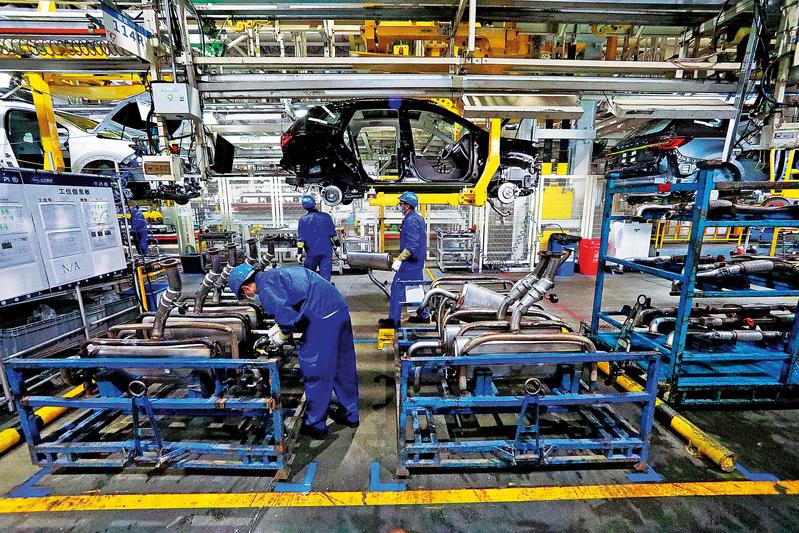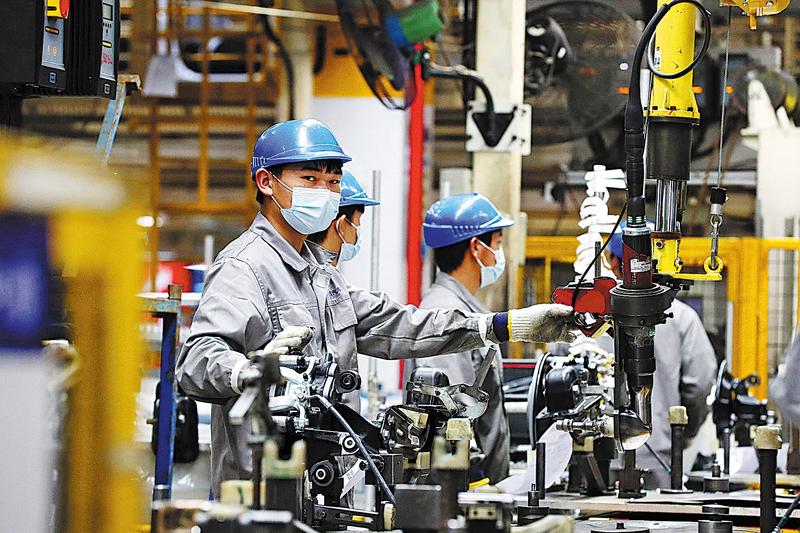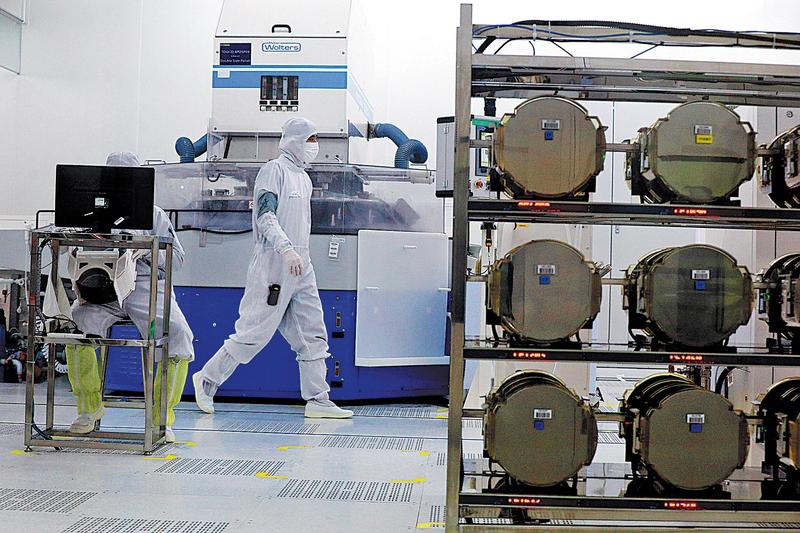 Production resumes at SAIC Motor’s plant in Shanghai’s Pudong New District on April 19. (ZHU XINGXIN / CHINA DAILY)
Production resumes at SAIC Motor’s plant in Shanghai’s Pudong New District on April 19. (ZHU XINGXIN / CHINA DAILY)
Agrowing number of manufacturers in Shanghai have relaunched their operations despite the challenges posed by COVID-19, showing confidence in the city’s economic outlook.
Resumption of production has been steadily advancing in the city, which as of May 19 had reported no new COVID-19 infections outside quarantine and lockdown populations for five straight days.
We have full confidence in China’s development, and we believe that pandemic-related challenges are only short-term.
Tao Lin, vice-president of Tesla Inc
At SAIC Motor’s vehicle production bases, single-shift output resumed at the end of April.
Online news platform ThePaper.cn quoted Wang Xiaoqiu, president of SAIC, as saying at the listed company’s annual performance news conference on May 5 that with the gradual recovery of supply and logistics chains, the manufacturer is working hard to make up its losses experienced during the outbreak.
Wang said the company’s capacity in Shanghai accounts for about 30 percent of the group’s total.
“Strictly following the epidemic prevention and control rules, we are relaunching our business at an accelerated pace, trying to increase capacity to the pre-epidemic level as soon as possible,” Wang said.
China’s largest listed automaker began stress tests at the plant on April 18, and the first complete vehicle rolled off the assembly line the next day.
As of April 29, up to 2,400 vehicles had left the restarted assembly line at SAIC Motor’s plant in Lin-gang on the southeastern fringes of Shanghai, said Chen Peifeng, a director at the factory.
“Our daily capacity currently amounts to about 300 vehicles, a rise of some 50 percent from the stress tests period,” Chen said.
Meanwhile, following resumed production at Tesla’s Shanghai Gigafactory on April 19, about 10,000 vehicles had been manufactured as of April 30, Wu Qiang, deputy governor of Pudong New Area, said at a news conference on May 7.
Located in Lin-gang Special Area, the part of the China (Shanghai) Pilot Free Trade Zone known for its high-end manufacturing industries, Tesla, as of May 16, had recovered about 45 percent of its capacity before the current COVID-19 outbreak, said Wu Xiaohua, deputy director of the Lin-gang administration, at a news briefing on May 17.
According to Wu, the area is home to 315 companies whose average annual sales revenue reaches at least 20 million yuan ($3 million). As of May 16, 301 of them had resumed production.
All the integrated circuit companies in Lin-gang have restored full production. The high-end equipment industry has seen its capacity utilization ratio recover to 50 percent, said Wu.
While the capacity utilization ratio for new energy vehicles in Lin-gang has reached 46 percent, that for the industrial chain supporting automobiles clawed back to 50 percent.
Wu explained the industrial chain of the automotive industry is relatively longer. Therefore, leading carmakers should resume production first to drive the complete recovery of the industrial chain. Tesla, for instance, has been coordinating with the production resumption of 100 suppliers as well as warehouses.
 Technicians work at a SAIC Motor plant in Shanghai on April 23. (ZHU XINGXIN / CHINA DAILY)
Technicians work at a SAIC Motor plant in Shanghai on April 23. (ZHU XINGXIN / CHINA DAILY)
Tesla sold 1,512 cars in China in April, down 98 percent from the level in March, said the China Passenger Car Association on May 10. The electric vehicle giant’s latest quarterly financial report released in late April said that although its Shanghai factory’s output fell by 50,000 cars due to the epidemic so far, its second-quarter output is still expected to keep pace with the first quarter’s level.
Tao Lin, vice-president of Tesla Inc, told China Business News: “We have full confidence in China’s development, and we believe that pandemic-related challenges are only short-term. Everyone is resolved to confront the challenges, and we think that production will soon fully recover.”
Qi Qi, an associate professor at Guangzhou Civil Aviation College in Guangdong province, said: “Smooth logistics are crucial for relaunching production. In order to ensure output, plants need to ship in raw materials and ship out products, enabling enterprises along the industrial chain to collaborate smoothly.”
There has been an obvious improvement in logistics services, especially after the central government’s call in the middle of April for efforts to keep industrial and supply chains stable, Qi said.
“With the joint efforts of the government and all parties involved, we have recently seen many advances in logistics, including vital raw materials and facilities transported by Eastern Air Logistics, the freight unit of parent company China Eastern Air Holding. This has made the recovery of related industrial chains possible during the pandemic,” Qi added.
At 1:12 am on May 9, an Eastern Air Logistics, or EAL, chartered cargo flight from the Japanese city of Osaka landed at Shanghai Pudong International Airport. The flight carried 41 metric tons of resources — 20 tons of raw materials urgently needed by high-tech enterprises and 21 tons of equipment and facilities — helping high-tech enterprises in Shanghai and the Yangtze River Delta region restore production, according to EAL.
In addition, Yan Feixiang, deputy general manager of EAL’s marketing division, said 45 tons of raw materials for high-tech enterprises were transported from South Korea and Japan by EAL from May 1 to May 8.
Thanks to sufficient preparation work, the shipments were completed with a high degree of efficiency, Yan added.
In early May, EAL was operating about 100 cargo flights a week nationwide, a rise of 43 percent from early April. Weekly cargo throughput rose by 56 percent.
At Shanghai’s two airports, EAL handled a total of 40,551 tons of cargo and mail in the first half of May, a rise of just over 69.6 percent month-on-month.
Yan said: “With more key foreign trade enterprises appearing on Shanghai’s ‘white list’ for resuming business operations, we will allocate additional cargo resources to help them. We are also working flat out to ensure industrial and supply chains flow smoothly.”
 Staff work at a silicone production factory in Pudong on April 29. (ZHU XINGXIN / CHINA DAILY)
Staff work at a silicone production factory in Pudong on April 29. (ZHU XINGXIN / CHINA DAILY)
Shanghai Pudong International Airport handles an average of 123 cargo flight arrivals and departures each day. In the two weeks from May 1 to 14, the airport’s average daily cargo throughput reached above 5,500 tons, a rise of just over 72.8 percent from the same period of April, according to the Shanghai Airport Authority.
Medical imaging and radiotherapy equipment maker Shanghai United Imaging Healthcare Co has witnessed the supply chain improvements.
Zhang Qiang, the company’s chairman, said, “This month, logistics services from Changzhou and Kunshan in Jiangsu province have become smoother, and several of our suppliers are on the white list to resume operations.”
Shanghai is an important international gateway for imports and exports, with the city playing a vital role in industrial and supply chains, not only in the Yangtze River Delta region but also nationwide and overseas.
Zhang Wei, the city’s vice-mayor, said during a news conference on April 22 that customs clearance and transportation efficiency have fallen below normal levels during the current outbreak of COVID-19.
As of April 30, Shanghai Port had restored 80 percent of its pre-pandemic capacity, while the average daily container throughput in April at the city’s Yangshan Port recovered to 85 percent of the level in the first quarter, according to public data.
Police at Shanghai General Station of Immigration Inspection have upgraded and optimized the cargo risk management system and simplified the customs clearance platform. As a result, cargo flight arrivals and departures rose by 49.6 percent from the same period a month ago, reaching a total of 1,980 flights, according to the station.
Industry insiders and experts said many challenges still lie ahead for a complete recovery of industrial and supply chains.
Qi, from Guangzhou Civil Aviation College, said: “The recovery of supply chains needs every single element along industrial chains to flow smoothly, be it raw materials, parts, facilities and equipment, or production, assembly, trade, logistics and others. To reach that point, we also have to ensure that the rules for pandemic prevention and containment are strictly followed.”
Xu Guangqing, a director of the passenger vehicles logistics division of SAIC Motor, said the company has been providing assistance to its downstream suppliers in resuming output.
“Along with the gradual recovery of logistics and supply chains, we have thoroughly evaluated conditions at about 400 of our suppliers. We have examined their capacity, stock and raw materials, as well as their staff numbers and production situation, so that we can provide assistance accordingly,” Xu said. “In the meantime, we are also working actively with government departments to work out green channels to ease pressure on supply and logistics chains.”
Contact the writers at wangying@chinadaily.com.cn


